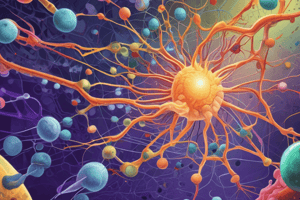Podcast
Questions and Answers
What is the primary function of a receptor?
What is the primary function of a receptor?
- To synthesize neurotransmitters
- To bind to ligands and initiate effects (correct)
- To act as an enzyme
- To regulate autacoids
What is the role of a transducer in a receptor-effector system?
What is the role of a transducer in a receptor-effector system?
- To convey signals to cellular targets (correct)
- To bind to ligands
- To act as an enzyme
- To synthesize neurotransmitters
What is the term used to describe the process of receptors acting as biochemical signal amplifiers?
What is the term used to describe the process of receptors acting as biochemical signal amplifiers?
- Ligand binding
- Catalysis (correct)
- Signal transduction
- Message propagation
What is the purpose of a receptor's ligand-binding domain?
What is the purpose of a receptor's ligand-binding domain?
What is the result of a single ligand molecule binding to a receptor that is an ion channel?
What is the result of a single ligand molecule binding to a receptor that is an ion channel?
What is the role of receptors in integrating extracellular information?
What is the role of receptors in integrating extracellular information?
What is the primary function of an effector protein?
What is the primary function of an effector protein?
What is the term used to describe the molecules that are synthesized or released by effector proteins?
What is the term used to describe the molecules that are synthesized or released by effector proteins?
What is the ability of a drug to combine with a receptor to form a drug-receptor complex?
What is the ability of a drug to combine with a receptor to form a drug-receptor complex?
What type of antagonism occurs when an antagonist binds reversibly to a receptor, and its inhibitory effects can be overcome by increasing the dose of the agonist?
What type of antagonism occurs when an antagonist binds reversibly to a receptor, and its inhibitory effects can be overcome by increasing the dose of the agonist?
What is the term for the ability of a drug to initiate a biological response?
What is the term for the ability of a drug to initiate a biological response?
What is the main difference between competitive and non-competitive antagonism?
What is the main difference between competitive and non-competitive antagonism?
What type of receptors are frequently plasma membrane-bound protein kinases?
What type of receptors are frequently plasma membrane-bound protein kinases?
What is the term for a drug that possesses both affinity and intrinsic activity?
What is the term for a drug that possesses both affinity and intrinsic activity?
What happens to the dose-response curve in competitive antagonism?
What happens to the dose-response curve in competitive antagonism?
What is the result of increasing the dose of an agonist in non-competitive antagonism?
What is the result of increasing the dose of an agonist in non-competitive antagonism?
Flashcards are hidden until you start studying
Study Notes
Receptor
- A receptor is a cellular macromolecule that binds to a drug to initiate its effects.
- Important drug receptors are cellular proteins that normally function as receptors for endogenous regulatory ligands, such as hormones, growth factors, neurotransmitters, and autacoids.
- A receptor has two main functions: ligand binding and message propagation.
- A receptor contains a ligand-binding domain and an effector domain to deliver these functions.
Receptor-Effector System
- A receptor, its cellular targets, and any intermediary molecules are referred to as a receptor-effector system or signal transduction pathway.
- Effector proteins may not be the ultimate cellular component affected, but may synthesize or release another signaling molecule, known as a second messenger.
Properties of Physiological Receptors
- Receptors act as integrators of extracellular information, coordinating signals from multiple ligands with each other and with metabolic activities of the cell.
- Physiological receptors act catalytically, amplifying biochemical signals.
- Even if a receptor is not an enzyme itself, it is still a formal catalyst.
Agonist
- An agonist is a drug that combines with a receptor, possessing both affinity and efficacy.
- Affinity is the ability of a drug to combine with a receptor, and efficacy is the ability to initiate an effect.
Antagonist
- An antagonist is a drug that possesses only affinity, with no intrinsic activity.
- Antagonists prevent the effect of an agonist but do not produce any effect of their own.
- There are two types of antagonism: competitive and non-competitive.
Competitive Antagonism
- In competitive antagonism, the antagonist binds reversibly to the receptor, and its inhibitory effects can be overcome by increasing the dose of the agonist.
- Maximum response can be obtained, and a rightward shift occurs in dose-response curves.
Non-Competitive Antagonism
- In non-competitive antagonism, the binding of the antagonist is irreversible or non-specific, and the antagonist cannot be overcome by increasing the dose of the agonist.
- The slope of the curve is changed, and the maximum response is decreased on increasing the dose of the antagonist.
Classification of Receptors
- One classification of receptors is as enzymes or receptor protein kinases.
- Receptors for peptide hormones that regulate growth, differentiation, and development are frequently plasma membrane-bound protein kinases that act by phosphorylating target proteins.
Studying That Suits You
Use AI to generate personalized quizzes and flashcards to suit your learning preferences.



